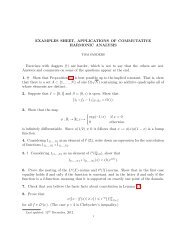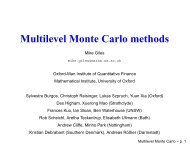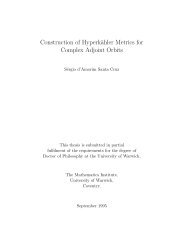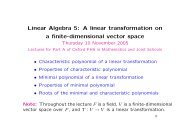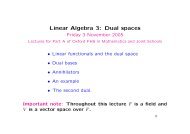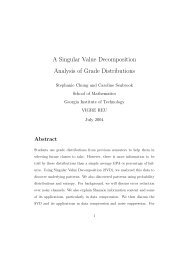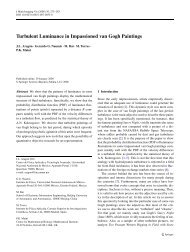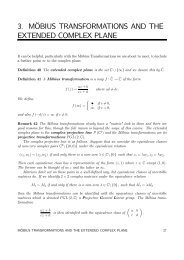Fourier Series and Partial Differential Equations Lecture Notes
Fourier Series and Partial Differential Equations Lecture Notes
Fourier Series and Partial Differential Equations Lecture Notes
You also want an ePaper? Increase the reach of your titles
YUMPU automatically turns print PDFs into web optimized ePapers that Google loves.
Chapter 2. <strong>Fourier</strong> series 10<br />
<strong>and</strong><br />
∂y<br />
(x,0) =<br />
∂t<br />
Hence, we want An, Bn such that<br />
αsin<br />
<br />
πx<br />
<br />
=<br />
L<br />
n=1<br />
∞<br />
n=1<br />
Bn<br />
∞ <br />
nπx<br />
<br />
Ansin , 0 =<br />
L<br />
<br />
nπc<br />
<br />
nπx<br />
<br />
sin . (2.6)<br />
L L<br />
∞<br />
n=1<br />
Bn<br />
<br />
nπc<br />
<br />
nπx<br />
<br />
sin . (2.7)<br />
L L<br />
By inspection we see that A1 = α, An = 0 for n = 1 <strong>and</strong> Bn = 0 ∀n. Thus, for these<br />
initial conditions, the solution is<br />
<br />
πx<br />
<br />
πct<br />
y(x,t) = αsin cos . (2.8)<br />
L L<br />
If we would like to take more general initial conditions<br />
y(x,0) = f(x),<br />
we need to find {An,Bn} such that<br />
f(x) =<br />
∞ <br />
nπx<br />
<br />
Ansin , g(x) =<br />
L<br />
n=1<br />
∂y<br />
(x,0) = g(x), (2.9)<br />
∂t<br />
∞<br />
n=1<br />
These are known the <strong>Fourier</strong> sine series of the functions f <strong>and</strong> g.<br />
2.1 Periodic, even <strong>and</strong> odd functions<br />
Definition f is a periodic function if there is an a > 0 such that<br />
Bn<br />
<br />
nπc<br />
<br />
nπx<br />
<br />
sin . (2.10)<br />
L L<br />
f(x+a) = f(x), ∀x ∈ R. (2.11)<br />
If this is the case a is called a period for f. Note that the period is not unique, but if there<br />
is a smallest such a, it is called the prime period of f.<br />
<strong>Notes</strong>.<br />
1. Observe that this means that f(x) = c for c constant does not have a prime period.<br />
2. Examples of periodic functions are sinx with prime period 2π <strong>and</strong> cos(2πx/a) with<br />
prime period a. Examples of non-periodic functions are x <strong>and</strong> x 2 .<br />
3. Observe that if f is defined on the half-open interval (α,α +a] we can extend it to<br />
be a periodic function by dem<strong>and</strong>ing it is periodic with period a. This is called a<br />
periodic extension.<br />
α−a<br />
y<br />
α α+a<br />
x




